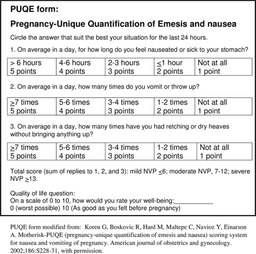
nvp, hyperemesis gravidarum and aph
Quiz by Safiyyah Aminudin
Feel free to use or edit a copy
includes Teacher and Student dashboards
Measure skillsfrom any curriculum
Tag the questions with any skills you have. Your dashboard will track each student's mastery of each skill.
- edit the questions
- save a copy for later
- start a class game
- automatically assign follow-up activities based on students’ scores
- assign as homework
- share a link with colleagues
- print as a bubble sheet
- Q1
1. What percentage of pregnant women suffer from hyperemesis gravidarum?
C) 10% to 12%
B) 4.0% to 6.2%
A) 0.2% to 3.6%
D) 10% to 20%
30s - Q2
2 . Which of the following is part of the definition of hyperemesis gravidarum?
C) Vomiting that appears after the 20th week of pregnancy
A) Vomiting that persists for the entire pregnancy
D) Severe nausea and vomiting with weight loss greater than 5% of prepregnancy body weight
B) Vomiting upon arising more than five days per week
30s - Q3
3 . Thiamine (vitamin B1) deficiency results in which potential maternal complication of hyperemesis gravidarum?
B) Esophageal rupture
C) Wernicke encephalopathy
A) Renal failure
D) Osmotic demyelination syndrome
30s - Q4
4 . Which of the following gestational hormones is hypothesized to be correlated with hyperemesis gravidarum?
A) Estrogen
D) Human chorionic gonadotropin (hCG)
B) Testosterone
C) Human placental lactogen (HPL)
30s - Q5
5 . Which of the following bacteria has been investigated as a cause of hyperemesis gravidarum?
B) Helicobacter pylori
A) Shigella
D) Group B streptococcus
C) Staphylococcus aureus
30s - Q6
6 . Nurses should make which of the following recommendations regarding prenatal vitamins to the patient with hyperemesis gravidarum?
A) Take prenatal vitamins after eating.
D) Stop taking prenatal vitamins containing iron until vomiting is resolved
C) Add an iron supplement to the prenatal vitamins.
B) Take prenatal vitamins before eating.
30s - Q7
7 . Which of the following dietary recommendations are effective in the management of hyperemesis gravidarum?
A) Eating high-fat foods
B) Drinking fluids with meals
D) Eating small, frequent meals
C) Removing salt from the diet
30s - Q8
8. Common causes of antepartum haemorrhage (APH, bleeding from the genital tract from 24 weeks' gestation) include which of the following?
F None of the above
A Vasa praevia
D Uterine rupture
B Undetermined origin
C Placenta praevia
E Placental abruption
30s - Q9
9. Regarding placenta praevia, which of the following are true?
D The patient should be routinely managed under inpatient care with delay of delivery until the patient labours, at which time caesarean section will be performed.
B Placenta praevia cannot be diagnosed with ultrasound.
C The majority of ‘low-lying’ placentas diagnosed at 20 weeks will remain so at term.
A Placenta praevia complicates about 0.4% of pregnancies at term
E Complications of placenta praevia include need for caesarean section, haemorrhage, placenta accreta, placenta percreta and hysterectomy.
30s - Q10
10. Placental abruption: which of the following are true?
A Many antepartum haemorrhages of ‘undetermined origin’ are probably small placental abruptions.
C Visible haemorrhage is absent in 20%.
D Risk factors for abruption include pre-eclampsia, autoimmune disease, maternal smoking, cocaine use and a previous history.
F Abruption is usually painless.
E Abruption is best diagnosed by ultrasound.
B Most of the blood loss is fetal.
30s